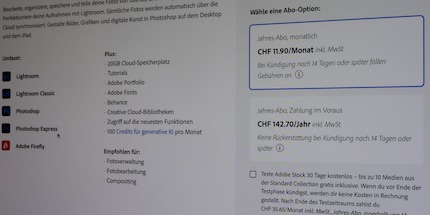
News + Trends
Plan for the mouse: Logitech is thinking about a long-lasting "Forever Mouse"
by Debora Pape

Logitech management’s idea of a perpetual subscription mouse seems ridiculous. Above all, however, it proves a trend: ever more offers are being turned into subscriptions. I’ll attempt to explain why this is the case.
In a podcast, Logitech CEO Hanneke Faber mentioned his idea for a subscription model with computer mice. A weird idea – mice are maybe the last thing suitable for a subscription. The comment provoked outrage. For some time now, subscriptions have seemingly been burrowing deeper and deeper into areas they don’t belong. Subscription models are becoming increasingly widespread, particularly in the software sector – often without any alternative and against the will of customers. Why?
Subscription models have been around for a long time, and they do make sense in many areas. Newspapers and magazines, for example. Due to their topicality, these products are short-lived and have to be constantly updated. A subscription made sense, at least before the internet age.
It’s the same for public transportation. If you commute, you use exactly the same ticket every day. So why not take out a subscription?
In both cases there’s – usually – no obligation to subscribe. But a subscription is more convenient and cheaper too if used frequently. As a result, customers benefit from the subscription.
A computer mouse is fundamentally different: you buy it once, then use it for years. Logitech’s managing director was by no means thinking of a subscription model that’d constantly replace your mouse. On the contrary, the same device would be kept as long as possible. Its subscription would consist of updates and services relating to the mouse.

In other words, a kind of service or software subscription. Subscription models are on the rise in the software sector. As software is constantly being further developed, this could make sense. They often also include services such as cloud storage, which would have to be paid for periodically anyway.
However, it isn’t clear to what extent a mouse would benefit from additional services. It’s a simple device, plug and play in the best sense of the word. I think there’s already enough devices in our everyday lives that need to be constantly updated. It’s nice to have things like mice that just work.
Even in places where software always has to be up to date, subscriptions are controversial. Very often, customers prefer buying software once, then owning it forever. A study by Deloitte (link in German) wasn’t really necessary to find this out. If users decided to subscribe of their own accord, there’d be no need to force them to do so. Adobe does it this way, for example.
Their subscriptions are priced pretty reasonably. At CHF 11.90 per month for Photoshop and Lightroom, you can use both programs for seven years before you exceed 1,000 francs. Photoshop alone used to cost that much. Without Lightroom. Smaller, regular payments also lower the barrier to entry.
But these subscriptions create a relationship of dependency. Unlike a newspaper or public transport subscription, there’s no easy way out. If I quit Adobe, I can’t even open my old files any more. This dependency bothers many.

From a company’s point of view, dependency is desirable – they call it customer loyalty. The other big advantage of subscriptions is that they generate regular and predictable income. This makes planning costs and investments much easier.
I suppose another advantage, especially in software development, is that there are no more deadlines to meet. A new feature is delivered when it’s ready – or when it’s in beta so it can be tested by a larger number of users.
In the past, subscription models also had disadvantages for providers. Once again, let’s use the traditional newspaper as an example. It has to be physically brought to each individual subscriber – a major effort that isn’t necessary with free newspapers. In addition, building up and maintaining customer data used to involve considerable effort. Free newspapers had to skip that too.
Today, these disadvantages have largely disappeared: customers maintain their data themselves. You create an account, enter your contact details, change your address when you move and renew or cancel your account yourself. Software and online media no longer have to be transported to the end customer.
As long as PCs were a growing market – according to these stats (link in German) until 2011 – companies like Logitech couldn’t care less that their products rarely had to be replaced. There were always new customers. This also applies indirectly to software companies such as Adobe.
There was another boost in 2020 and 2021, since many people needed a workstation at home too. However, the long-term projection is clearly trending downwards. Most people have what they need. New products are only acquired selectively.
So, companies have to find new ways to keep customers on board. Subscriptions are an obvious option. However, this also requires an offer that needs periodic replacement.
Many subscriptions use flat rates. They offer so much, way more than you’d ever use. Take music streaming portals. Sounds good.
But this goes hand in hand with a feeling of having to consume as much as possible. The subscription has to be used; otherwise it’s not worth it.
At the all-you-can-eat buffet, you have to eat more than is good for you. The situation is very similar on streaming portals and in Game Pass. Binge-watching, binge gaming, the supposed dream becomes a nightmare.
Subscription models are a way of pushing even more onto users who already consume too much. It’s the answer to a new form of overproduction.
Ever since the first textile factories began operating in the 18th century, companies produced more than could be consumed. In the digital age, overproduction extends to games, software, films and other media. Productivity has improved enormously. But there’s no answer to the question of who’s actually supposed to consume all this stuff.
According to a study from 2023, 45.6 million songs have never been listened to on streaming portals. Not even once. Trending strongly upward. Generative AI will multiply this figure once again.
Some subscriptions exist because there’s a customer need. Others are merely there to maintain turnover and make planning easier. Others are an attempt to get to grips with overproduction.
Fortunately, however, things don’t always happen the way managers think they will. Mobile phones come to mind as a counter-example. Whereas 10 or 15 years ago it was common practice to get a new device every two years as part of a binding contract, this sales model seems less common today. People are increasingly buying what they really need again – and that could be nothing at all for a few years.
My interest in IT and writing landed me in tech journalism early on (2000). I want to know how we can use technology without being used. Outside of the office, I’m a keen musician who makes up for lacking talent with excessive enthusiasm.
Interesting facts about products, behind-the-scenes looks at manufacturers and deep-dives on interesting people.
Show all
Background information
by Debora Pape

Background information
by Florian Bodoky

Background information
by Rainer Etzweiler